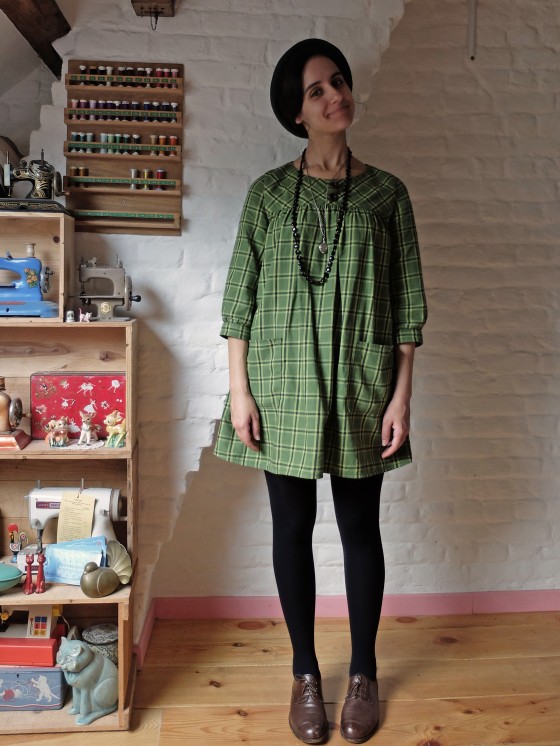 I had been wanting to sew the Aubépine dress in this fabric for a little over a year. I got the fabric at a swap last year and even though I didn’t like its colour, a very pale yellow, I thought it would be perfect for the dress once I had dyed it a beautiful purple.
I had been wanting to sew the Aubépine dress in this fabric for a little over a year. I got the fabric at a swap last year and even though I didn’t like its colour, a very pale yellow, I thought it would be perfect for the dress once I had dyed it a beautiful purple.
 I was sure it was either all viscose or a viscose and cotton blend, but judging from the result of the dyeing, it must be a viscose and synthetic blend: the weft came out a perfect purple while the warp stayed the exact same pale yellow as before. Ah well I thought, it’s still a nice colour!
I was sure it was either all viscose or a viscose and cotton blend, but judging from the result of the dyeing, it must be a viscose and synthetic blend: the weft came out a perfect purple while the warp stayed the exact same pale yellow as before. Ah well I thought, it’s still a nice colour!
What I didn’t like (and still don’t) is that once dyed, the fabric got sort of a shiny quality. Not only do I not like that per se, but it also has the unwanted effect of emphasising each and every crease. And unfortunately, there are a lot of creases on this dress!
 I knew the fabric was prone to distortion, so I had planned on using fusible bias tape to stabilise the neckline and armholes. But I didn’t have any in stock and I didn’t think to staystitch instead, so between the pressing and sewing of the tucks and darts and other manipulations, when I sewed the shell and lining together, the shell bodice had grown bigger than the lining bodice.
I knew the fabric was prone to distortion, so I had planned on using fusible bias tape to stabilise the neckline and armholes. But I didn’t have any in stock and I didn’t think to staystitch instead, so between the pressing and sewing of the tucks and darts and other manipulations, when I sewed the shell and lining together, the shell bodice had grown bigger than the lining bodice.
So while the lining is a perfect fit, the exterior fabric is kind of a mess. There are creases everywhere on the front bodice even after the most careful pressing. The back bodice is a little better except for a few centimetres at the sleeve seams.
 Another bad choice I made was forgetting that the waist seam was going to be enclosed in the waist casing and using French seams there that were not only not needed, but that added bulk in the casing.
Another bad choice I made was forgetting that the waist seam was going to be enclosed in the waist casing and using French seams there that were not only not needed, but that added bulk in the casing.
All of that is not bad enough that I don’t want to wear the dress, but it does make me a bit self-conscious at times, and then I have to remind myself that people who don’t sew won’t notice there’s anything wrong with my dress.
 And the dress is so comfortable that it would be a shame not to wear it! I even replaced the drawstring with a piece of elastic for maximum comfort. For that I didn’t make two buttonholes at the front of the dress but only one buttonhole at the back of the lining, to be able to thread the elastic through the casing.
And the dress is so comfortable that it would be a shame not to wear it! I even replaced the drawstring with a piece of elastic for maximum comfort. For that I didn’t make two buttonholes at the front of the dress but only one buttonhole at the back of the lining, to be able to thread the elastic through the casing.
 Except for the replacement of the drawstring with elastic, I followed the instructions to the letter. The step I dreaded most was making the tucks and this was actually a piece of cake. The part I found most tedious was basting the shell and lining waist seams together before sewing the casing: this took way too much time. Other than that, I really enjoyed the process of sewing this dress.
Except for the replacement of the drawstring with elastic, I followed the instructions to the letter. The step I dreaded most was making the tucks and this was actually a piece of cake. The part I found most tedious was basting the shell and lining waist seams together before sewing the casing: this took way too much time. Other than that, I really enjoyed the process of sewing this dress.
And I love the lining I used: it’s a beautiful silk that was a delight to sew and that is a delight to wear. I wasn’t keen on using the recommended cotton voile as a lining because of static cling with tights (it is a fall dress after all), and this silk is a perfect substitute.
 As a matter of fact, the beauty of the lining, the fact that everything is French seamed and my issues with the outside bodice mean that the dress is almost prettier inside than outside!
As a matter of fact, the beauty of the lining, the fact that everything is French seamed and my issues with the outside bodice mean that the dress is almost prettier inside than outside!













